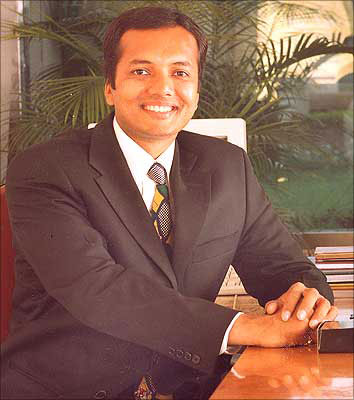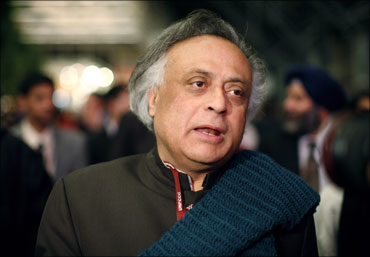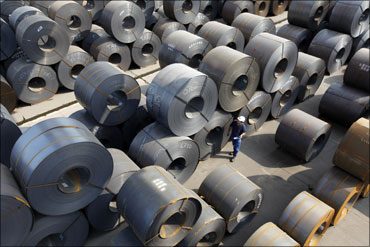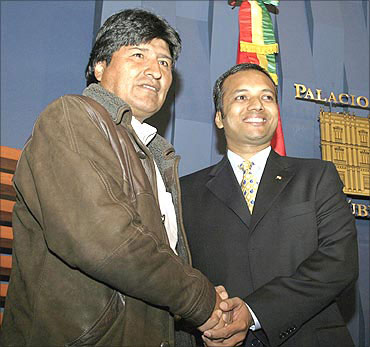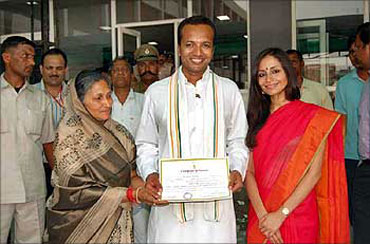 | « Back to article | Print this article |
The story behind why govt nixed Congress MP Jindal's power project
The Union Ministry of Environment and Forests (MoEF) headed by Jairam Ramesh has withdrawn the permission it had earlier granted for the construction of a major power project in Chhattisgarh by a company headed by high-profile Congress Member of Parliament from Kurukshetra, Haryana, Naveen Jindal.
The fact that one Congress minister and MP nixed a project being promoted by another MP belonging to the same political party is not the only unusual aspect of this episode. This is also a rare instance of the central government acting on the basis of complaints made by a civil society organisation against a large industrial group.
On June 18, the MoEF dashed off letters to Jindal Power Corporation (JPL) -- a subsidiary of Jindal Steel & Power Limited whose chairman is Naveen Jindal -- and the government of Chhattisgarh withdrawing a letter sent by the ministry in March 2009 that prescribed the terms of reference (TOR) to JPL for its proposed power plant at Tamnar in Raigarh district of Chhattisgarh.
Accusing the JPL of having started construction of the power plant 'without obtaining prior environmental clearance', the MoEF directed the Chhattisgarh government to take action against the project's promoters by invoking legal powers under Section 19 of the Environment (Protection) Act, 1986.
The Union ministry added that the proposal for setting up such a plant was 'premature'.
Click NEXT to read on. . .
The story behind why govt nixed Congress MP Jindal's power project
The proposed power plant of 2,400 megawatt capacity was to be set up over an area of 1,041 hectare near an existing power plant belonging to the same company having a capacity of 1,000 MW. The total investment for the project was envisaged at around Rs 13,410 crore (Rs 13.410 billion).
Of this amount, a consortium of 23 lenders led by the State Bank of India has sanctioned Rs 10,057 crore (Rs 100.57 billion). The loan agreement was executed on March 26 in New Delhi. The remaining amount of Rs 3,353 crore (Rs 33.53 billion) was to be raised through the sale of equity shares and through internal accruals.
Earlier, the MoEF had asked JPL to prepare an Environmental Impact Assessment (EIA) report when the company had approached the ministry for permission to construct the power plant.
In a letter addressed to JPL dated March 31, 2009, the MoEF had prescribed the TOR for the power project and had directed JPL to conduct a public hearing after the preparation of the EIA report.
Click NEXT to read on. . .
The story behind why govt nixed Congress MP Jindal's power project
However, when the regional officer of Chhattisgarh Environment Control Board (CECB) inspected the site on February 22 this year, he found that work on constructing the power plant had started even before the company had received the required environmental clearance.
The ministry also received a complaint from a non-government organisation, Jan Chetna, headed by Ramesh Agrawal, a resident of Raigarh, alleging that JPL had started building the power plant without obtaining the necessary clearance under the provisions of the Environmental Impact Assessment Notification, 2006.
The complainant alleged that JPL had deliberately ignored the objections that had been raised against the project by various sections.
In a telephonic interview from Raigarh with rediff.com, Agrawal claimed that even the public hearing was hastily arranged and conducted by the local administration after pressure was exerted by his NGO as well as other civil society groups representing the residents of Raigarh.
Click NEXT to read on. . .
The story behind why govt nixed Congress MP Jindal's power project
In May, the MoEF had set up a committee, comprising officers from its regional office in Bhopal, Madhya Pradesh and the CECB, besides a former officer of the Chhattisgarh Pollution Control Board, to examine the complaints that had been made against the project.
After a site inspection, the committee confirmed the allegations made by the complainant that construction of the plant had commenced without obtaining the prior permission of the competent authorities.
The committee found that work had begun on building four power generating units, each of a capacity of 600 MW. The 1,041-ha area on which the project was being built had already been allotted to the Chhattisgarh Mineral Development Corporation (CMDC) after it had been designated a coal-bearing block.
It is estimated that this area spread across 60 square kilometres contains around 1,000 million tonnes of coal. Though JPL had applied to the CMDC for a no-objection certificate to build the power plant, the NOC never came despite reports that influential individuals had lobbied on behalf of the company.
Click NEXT to read on. . .
The story behind why govt nixed Congress MP Jindal's power project
Sunil Kumar, editor of a local daily Dainik Chhattisgarh, which first raised this issue told rediff.com over the phone that the state government received so many written objections to the power project that these sheets of paper filled up two gunny sacks!
He pointed out that as per official rules, a public hearing should have been conducted only after the company received an NOC from the CMDC but this did not happen in this instance.
The editor added that N. Baijendra Kumar, principal secretary to the Chhattisgarh government, had pointed out that the March 2009 clearance to the project had been granted by the MoEF before the complaints from the public and from NGOs had been forwarded to the Union ministry by the state government.
According to the June 18 letter written by the MoEF to JPL, even though the NOC was not granted by the CMDC, JPL claimed it had started construction of the power project over an area of 62 ha which, according to the ministry, was 'not possible'.
Click NEXT to read on. . .
The story behind why govt nixed Congress MP Jindal's power project
This was because the TOR for the power plant had specified a land area requirement of 1,041 ha, of which 491 ha was for the ash dyke, 100 ha for the water reservoir and 100 ha for the residential colony.
The MoEF's letter added that the ministry had 'not been informed' about a 'change in (the) location of the proposed power project'.
The letter asked the project authorities to submit a 'clear proposal' for the plant and 'follow the provisions of the EIA notification, 2006 in case they (meaning JPL) want to pursue this project'.
When contacted by rediff.com, an official spokesperson of JPL who did not wish to be identified, denied that any construction of the new power plant was in progress.
Click NEXT to read on. . .
The story behind why govt nixed Congress MP Jindal's power project
In an e-mailed response, he claimed that the activity that had taken place in the site pertained to the construction of a second stacker reclaimer for the company's existing 4x250 MW power plant as the main stacker reclaimer had been frequently breaking down resulting in interruptions in the generation of power.
The spokesperson added that because of the objections of the local people and certain NGOs, the company had stopped construction of the new power plant. He denied that the project was being sought to be built over an area of 62 ha instead of the originally-envisaged 1,041 ha.
The JPL spokesperson claimed that the "TOR has been withdrawn (by the MoEF) based on incorrect information that our company will now be putting up the entire power project on 62 ha (of) land whereas (the) TOR was granted to put up the project on 1041 ha (of) land."
He contended that the 'factual position' was that "because of problems in acquiring land in that particular area, we have tried to optimize land usage from 1041 ha to 456 ha."
Click NEXT to read on. . .
The story behind why govt nixed Congress MP Jindal's power project
"Instead of two ash dykes proposed in the TOR, we are now proposing (the construction of) one ash dyke (over 241 ha) and (a) water reservoir of same size (100 ha) will come up at the same location," the JPL spokesperson stated, adding: "The main power plant will now be coming up on 115 ha instead of 350 ha proposed earlier. This has become possible because we have shifted (a) pipeline and such other facilities and tried to vacate some area from the existing plant."
He went on to claim: "As far as (the) housing colony is concerned, we had earlier proposed (that this be built on) 100 ha. Since the land is not available, we will be accommodating employees of the new power project in the existing colony of JPL as well as the existing colony of our group company, Jindal Steel & Power Ltd which is situated 25 km away."
The spokesperson said that 'if required', the company would build a smaller residential colony at a new location after obtaining the permission of the Chhattisgarh government and that this was permitted under the MoEF's guidelines.
"The company has only optimised the land usage without changing the location of the main plant or any of the other facilities," he stated.
Click NEXT to read on. . .
The story behind why govt nixed Congress MP Jindal's power project
The JPL spokesperson said the company would represent its case to the state government and the MoEF. He claimed the withdrawal of the TOR was 'unfair' since the company was not 'given an opportunity' to present its case.
He further contended that the delay in the construction of the project would increase costs and hurt the financial interests of JPL.
It remains to be seen how the recent withdrawal of permission to set up a power plant by JPL would impact the Rs 7,200 crore (Rs 72 billion) mega-IPO (initial public offering) proposed by Jindal Steel and Power for which a draft red herring prospectus was filed before the Securities and Exchange Board of India in December.
Tailpiece: Jairam Ramesh had served as economic adviser to the Chhattisgarh government between 2001 and 2003.
